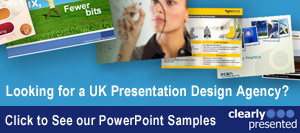
 Written
by Jim Endicott of Distinction
Written
by Jim Endicott of Distinction
After dragging myself out of bed at 6:30 each morning, I shower, shave and head out to order my morning coffee: a single tall mocha, light on the chocolate, extra hot, and double-cup it please. With those relatively simple instructions, you’d think that no matter where I went for my espresso, it would all taste the same. But guess what? It doesn’t.
Even if I go back to the same coffee shop, my "usual" tastes a little different from one day to the next. All the ingredients remain the same – the coffee beans, the chocolate, the milk – so how can it get screwed up?
The answer, of course, is
that the flavor of a single tall mocha depends as much
on the person behind the counter as the ingredients
in the cup.
When it comes to the quality of the presentations we
create, the difference between a good presentation and
a great one seldom comes down to software. Instead,
it’s the person "behind the counter" – crafting
the message and using the tools creatively – who ultimately
makes the difference.
Among the many presentation graphics programs to choose from – PowerPoint, Freelance, Corel Presentations, Astound – it really doesn’t matter which one you decide to use. (I’m guessing that statement got your attention.) Personally, I take it as a bit of an insult when someone describes my presentation in terms of the software I used to make it. After all, you’re probably not too concerned about which Web development tool was used to lay out this newsletter, are you?
Regardless of the claims made by the world-class marketing organizations behind these products, a truly great presentation doesn’t hinge on clip-art galleries, transition effects, chart types or bullet-point shapes. These things are all well and good, to the degree they can help you become more productive (and occasionally, more creative). But a great presentation relies far more on three mission-critical things that all great presenters do.
Craft a Compelling Message
Your presentation software may have all the bells and whistles, but I guarantee you’re not going to find a "message wizard" to help stake out your content. A good business message starts from a high-level, big-picture view and flows down to an appropriate level of detail. A good message isn’t preoccupied with itself, but rather focuses on the value it brings to the audience.
Good content will seamlessly steer your audience through your entire message, keeping the topics clean and well defined and making the relationship among various topics clear. Graphical sign-posts along the way let the audience know where they are and where they’re headed.
At its conclusion, a good presentation summarizes the key themes in a way that makes the audience feel like they just got off the Jungle Cruise at Disneyland. They learned some stuff, had an enjoyable ride with a few surprises along the way – and knew exactly where they were when the ride was over.
Avoid the Text Trap
Bullet-point text is one of the easiest ways for presenters to communicate information. Unfortunately, it’s also one of the worst ways to do so. Why? Processing text is very much a left-brain kind of thing. When we read, we filter and eliminate based on existing perceptions; whatever information our brains don’t filter out goes into short-term memory. This approach may be good if you’re building nuclear weapons, but it can be very bad if you’re trying to sell a product or service to a tough audience.
In contrast, sensory-based information is much more likely to go into long-term memory. Think of ways to replace bulleted lists with something more visual – for example, an animated flowchart (with supporting images) that walks the audience through a series of steps and is triggered by mouse clicks.
Create a Unique Identity
Fortunately for business presenters, you don’t have to have a body part pierced in order to demonstrate your individualism – but to make your story memorable, you need to do something to create a unique presentation identity.
You may be fortunate enough to find a stock PowerPoint template that hasn’t already been worked to death, but you still need to personalize it with elements like corporate colors, images and logos. Another way to come up with a unique look is to find someone who can help you design a professional-looking, audience-appropriate presentation with easy-to-read fonts.
Bottom line:
As feature-rich as today’s software is, your success as a presenter is not determined by the particular program you use. (I’ve seen some very bad presentations come from very expensive software.) Whether it’s mochas or marketing plans, it pays to find the person behind the tools who can provide the biggest jolt for your jingle.








